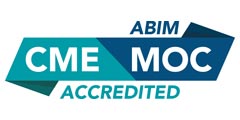
CME: Best practices and opportunities for improvement in the medical management of Dravet syndrome: damn it, Dravet – what to do
Activity Description / Statement of Need:
In this online, self-learning activity:
Dravet syndrome (DS) is a rare form of early-onset epilepsy syndrome affecting between 1:16,000 and 1:46,000 and is associated with pleomorphic seizure activity, cognitive decline, motor, and behavior abnormalities. Sudden unexpected death in epilepsy is the cause of death in nearly half of the deaths in patients with DS, with the mean age of death 8.7 years old and 73% of deaths occurring before age 10. Seizures typically begin in the first year of age, with most occurring between months 5 and 8, and it is usually a prolonged, tonic-clonic (accounting for 52% of first seizures) or hemiclonic (35%) seizure. Environmental triggers or events, such as fever, acute stress, and physical exercise may precipitate seizures, and at least 85% of those who are clinically diagnosed with DS have variations in the SCN1A gene. Unfortunately, diagnosis is not uncommonly delayed until a patient 3 years of age or older, prior to which antiseizure medication selection may be suboptimal or ineffective, which may lead to seizure exacerbation, an increased risk of status epilepticus, and worse cognitive outcomes.
Target Audience:
HCPs including but not limited to: neurologists, primary care physicians, and pediatric specialists; physician assistants, nurse practitioners, and pharmacists who practice in neurology; and any other clinicians who commonly encounter potential patients with DS.
Commercial Support Disclosure: This program is supported by an educational grant from UCB.
This activity is free of charge.
Release Date: March 02, 2025 -- Expiration Date: March 02, 2027
Faculty: Joseph E. Sullivan, MD
Agenda
|
Faculty Introductions, disclosures |
|
Background: review of DS
· Challenges in diagnosis |
|
Best practices and updates in management
· Patient case(s) |
|
Summary, conclusions, and best practice recap |
Learning Objectives
By the end of the session the participant will be able to:
- Summarize the presenting signs and symptoms of Dravet syndrome (DS) as well as the health care burden unique to patients with DS over time.
- Recall the present and emerging therapies for DS.
- Formulate a treatment plan for a patient with DS.
Accreditation
ACCME Activity #202948388
ScientiaCME is accredited by the Accreditation Council for Continuing Medical Education (ACCME) to provide continuing medical education for physicians.
Credit Designation: ScientiaCME designates this educational activity for a maximum of 1.0 AMA PRA Category 1 Credit(s)™ toward the AMA Physician's Recognition Award. Physicians should only claim credit commensurate with the extent of their participation in the activity.

ABIM MOC Recognition Statement: Successful completion of this CME activity, which includes participation in the evaluation component, enables the participant to earn up to 1.0 MOC points in the American Board of Internal Medicine's (ABIM) Maintenance of Certification (MOC) program. It is the CME activity provider's responsibility to submit participant completion information to ACCME for the purpose of granting ABIM MOC credit.
ABIM MOC Credit Type: Medical Knowledge
ABP MOC Recognition Statement: Successful completion of this CME activity, which includes participation in the evaluation component, enables the participant to earn up to 1.0 MOC points in the American Board of Pediatrics' (ABP) Maintenance of Certification (MOC) program. It is the CME activity provider's responsibility to submit participant completion information to ACCME for the purpose of granting ABP MOC credit.
ABP MOC Credit Type: Lifelong Learning and Self-Assessment
Physicians: For maintenance of certification (MOC) points, you must enter your board certification ID # and birth date correctly. It is the learner's responsibility to provide this information completely and accurately at the completion of the activity. Without providing it, the learner will NOT receive MOC points for this activity. By providing this data, you acknowledge that it will be shared with ACCME and the applicable certifying board. Please note: Not all activities on this site provide MOC points. If this activity does not specify that it provides MOC points in this section, then it does NOT provide MOC points. This activity provides MOC points only for ABIM and ABP.
Pharmacists
ScientiaCME is accredited by the Accreditation Council for Pharmacy Education (ACPE) as a provider of continuing pharmacy education. This activity is approved for 1.0 contact hours of continuing pharmacy education credit. Proof of participation will be posted to your NABP CPE profile within 4 to 6 weeks to participants who have successfully completed the post-test. Participants must participate in the entire presentation and complete the course evaluation to receive continuing pharmacy education credit. ACPE #0574-0000-25-008-H01-P. This is an Application (A)-type activity.

Pharmacists: You must enter your NABP # and birth date correctly so that proof of participation can be posted to your NABP CPE profile. It is the learner's responsibility to provide this information completely and accurately at the completion of the activity. Without providing it, the learner will NOT receive CPE credit for this activity.
Nurses: The American Nurses Credentialing Center (ANCC) accepts AMA PRA Category 1 Credit(s)™ from organizations accredited by the ACCME. This activity is designated for up to 1.0 AMA PRA Category 1 Credit(s)™.
Physician Assistants: The American Academy of Physician Assistants (AAPA) accepts AMA PRA Category 1 Credit™ assigned by organizations accredited by the ACCME as satisfying Category 1 CME for National Commission on Certification of Physician Assistants (NCCPA) national certification maintenance. This activity is designated for up to 1.0 AMA PRA Category 1 Credit(s)™.
Nurse Practitioners: The American Academy of Nurse Practitioners Certification Board (AANPCB) states that continuing education providers accredited by the ACCME may provide acceptable, accredited Advanced Practice Provider content. This activity is designated for up to 1.0 AMA PRA Category 1 Credit(s)™.
Faculty Disclosure and Resolution of COI
As a provider of continuing medical education, it is the policy of ScientiaCME to ensure balance, independence, objectivity, and scientific rigor in all of its educational activities. In accordance with this policy, faculty and educational planners must disclose any significant relationships with commercial interests whose products or devices may be mentioned in faculty presentations, and any relationships with the commercial supporter of the activity. The intent of this disclosure is to provide the intended audience with information on which they can make their own judgments. Additionally, in the event a conflict of interest (COI) does exist, it is the policy of ScientiaCME to ensure that the COI is resolved in order to ensure the integrity of the CME activity. For this CME activity, any COI has been resolved thru content review by ScientiaCME.
Disclosures of Faculty: Joseph E. Sullivan, MD, Professor of Neurology & Pediatrics, UCSF School of Medicine, has received financial compensation from Jazz Pharmaceuticals, UCB, Marinus Pharmaceuticals, BrightMinds, Longboard, Ceribell as a consultant; in addition to grant/research work from Zogenix, UCB, Stoke Therapeutics, Encoded Therapeutics, Xenon Pharmaceuticals, Neurocrine Biosciences, Takeda; in addition to serving on the Data and Safety Monitoring Board for Neuropace and a stockholder (restricted stock units) of Zynerba.
Disclosures of Educational Planners: Charles Turck, PharmD, BCPS, BCCCP, President of ScientiaCME, has no relevant financial disclosures.
Faculty WILL discuss off-label uses of a commercial product.
All relevant financial relationships have been mitigated.
ScientiaCME adheres to the ACCME’s Standards for Integrity and Independence in Accredited Continuing Education. Any individuals in a position to control the content of a CE activity, including faculty, planners, reviewers or others are required to disclose all relevant financial relationships with ineligible entities (commercial interests). All relevant conflicts of interest have been mitigated prior to the commencement of the activity.
Commercial Support Disclosure: This program is supported by an educational grant from UCB.
Instructions
- Read the learning objectives above
- Take the Pre-Test (optional). Completion of the pre-test will help us evaluate the knowledge gained by participating in this CME activity.
- View the online activity. You may view this is in more than one session, and may pause or repeat any portion of the presentation if you need to.
- Minimum participation threshold: Take the post-test. A score of 70% or higher is required to pass and proceed to the activity evaluation.
- Complete the activity evaluation and CME registration. A CE certificate will be emailed to you immediately.
System Requirements
Windows 7 or above
Internet Explorer 8
*Adobe Acrobat Reader
Mac OS 10.2.8
Safari or Chrome or Firefox
*Adobe Acrobat Reader
Internet Explorer is not supported on the Macintosh
*Required to view Printable PDF Version
Please take a few minutes to participate in the optional pre-test. It will help us measure the knowledge gained by participating in this activity.